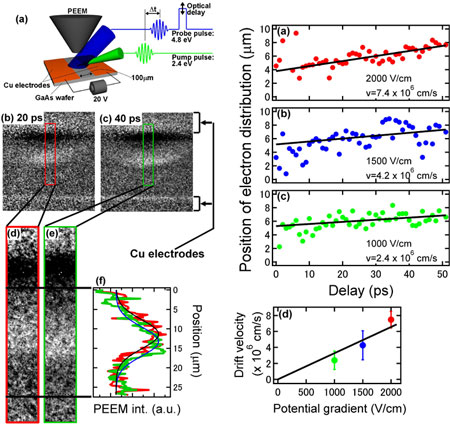| Posted: Oct 29, 2014 |
Imaging of electrons moving around at 80,000m per second in semiconductor
|
|
(Nanowerk News) Postdoctoral fellow Keiki Fukumoto, together with researcher Ken Onda and Professor Shinya Koshihara, all of the Graduate School of Science and Engineering at the Tokyo Institute of Technology, succeeded in direct observation and video imaging of electron flow at 80,000m per second in a semiconductor ("Direct imaging of electron recombination and transport on a semiconductor surface by femtosecond time-resolved photoemission electron microscopy").
|
|
They did so by combining a new laser pulse light source and a photoemission electron microscope (PEEM) to develop an ultra high-speed microscope that enabled visualization of electrons on a 20 nanometer and 200 femtosecond scale.
|
 |
| Fig. 1 (left): Time-resolved PEEM video imagery of electron movement. (a): Outline of measurement method. (b)&(c): Photoelectron microscope images after laser irradiation at 20ps and 40ps. (d)&(e): Magnifications of the center areas of (b)&(c). (f): Electron movement can be confirmed from the vertical-direction profiles in (d)&(e). Fig. 2 (right): (a),(b),(c) are the movement ranges for electrons plotted against time using the electric field gradient between different electrodes (voltage value ÷ electrode interval). The movement speed of the electrons is calculated from the linear fit inclination. (d) is electron movement speed plotted against the electric field gradient. (click on image to enlarge)
|
|
Semiconductors are widely used in PCs, mobile phones and solar batteries, and have become indispensable, but there had been no method to view the movement of the carriers (electrons) that controlled their behavioral functions.
|
|
With the advance of the nano-sizing of semiconductor elements, attention is on the development of elements (transistors, solar batteries, LEDs, quantum computers) that use the resulting quantum size effect. Devices able to visually assess that electrical conductivity are expected to have a major impact on future semiconductor element development.
|

